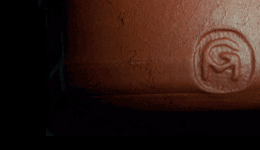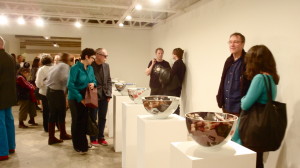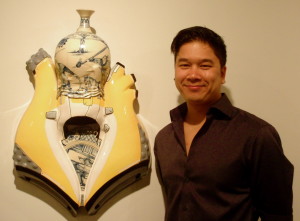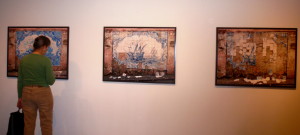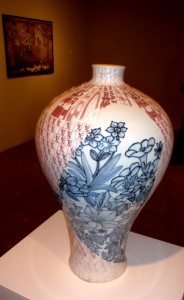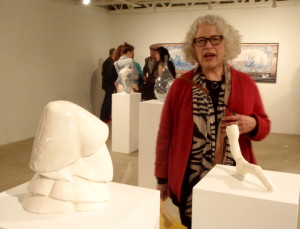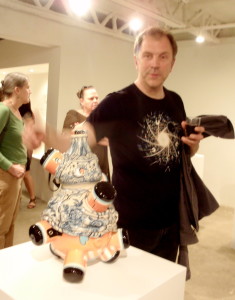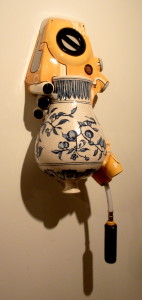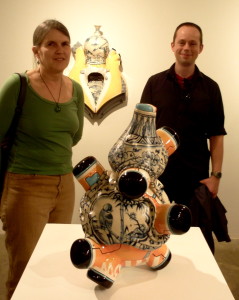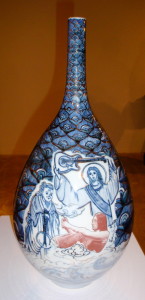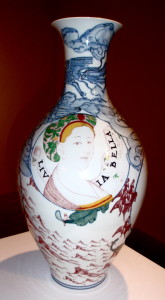Last night I took sky train from Lougheed Town Centre to Granville station and emerged on Dunsmuir Street. Satellite Gallery is at 560 Seymour street, just nearby. I took the elevator up one floor and was just in time to say hello to fellow potters and take a seat before curator Louis-Alexandre Douesnard-Malo introduced speaker Paul Mathieu at 6pm.
To see the invitation and read the curator’s statement and biographies of the 5 featured artists go to this link:
http://www.satellitegallery.ca/
Paul was invited to give us some information on how his work came about, why he uses porcelain and his intention in the creating of his elegant bowls at JingdeZhen, China. He has been a resident artist in this porcelain-manufacturing area of China several times and has found exactly the right artisans to make his bowl designs, paint his digital photographs precisely or apply ceramic ink photographic decals. It’s almost impossible to detect the difference between these two decorating methods. Why porcelain? because it is the whitest of clays to enhance his colourful surfaces. His intention has to do with the perception of inside/outside, cultural expectations and art world traditions regarding images. His bowls are one aspect of Elegant Disorder.
Brendan Tang, another of the artists invited to be part of this conceptual show, was in town for the opening. His Manga/Ormulu pieces are intended to surprise the viewer with their combination of Oriental products. The traditional-seeming blue and white vessels (which are not porcelain) appear to stretch, bulge and fold over shiny 3D constructions inspired by Japanese Manga cartoon drawings. In his take on Elegant Disorder he has us consider the earlier cultural overlay of Chinese porcelain which became Ormulu with baroque embellishments when all things Oriental were highly sought-after in earlier centuries, but further altered by being married with very contemporary Oriental Cartooning.
Shelley Miller’s work is not porcelain either. She has taken 3 large photographs of a blue and white tiled wall. These tiles could have been Turkish, Spanish, Mexican or Dutch but she has made them like Portuguese tiles and installed them in (I think) Brazil. They are made, not in clay at all, but in sugar. So the inevitable deterioration of the surfaces and even the ‘glue’ as they smash on falling is recorded and serves to bring our attention to the imbalance of power in global trade versus the usual permanence of ceramics. Here is her Elegant Disorder.
Sin-Ying Ho’s work is much like what we have come to expect from artists who take advantage of the amazing facilities and abilities of the porcelain makers in Zhing de Zhen. She has chosen vases from the stock available there and applies unexpected images with decals on their surfaces. The forms are elegant but we come closer and see that she has taken religious, commercial and cultural images, applying them to glazed and unglazed areas and over peeling terra sigillata. Not as comfortable as the traditional all-over consistent blue and white design we expect. Her Elegant Disorder.
The 5th artist, Elizabeth Zvonar’s two pieces followed the theme of the show. Her forms are taken from fingers and elbows and clear glaze drips over some parts. This Elegant Disorder contribution made me feel uncomfortable, but then I am a person, like Paul Mathieu, who is fascinated with the functional object.
I enjoyed the opportunity to see and touch most of the work in the show, as is the case with ceramics usually, unlike the hands-off rules normal in galleries. Reading Louis-Alexandre’s notes subsequently has made me think about these Perspectives and I think the show warrants a visit. And I wish the curator success in his chosen career, especially as he seems interested in using ceramics in a Fine Art setting!
